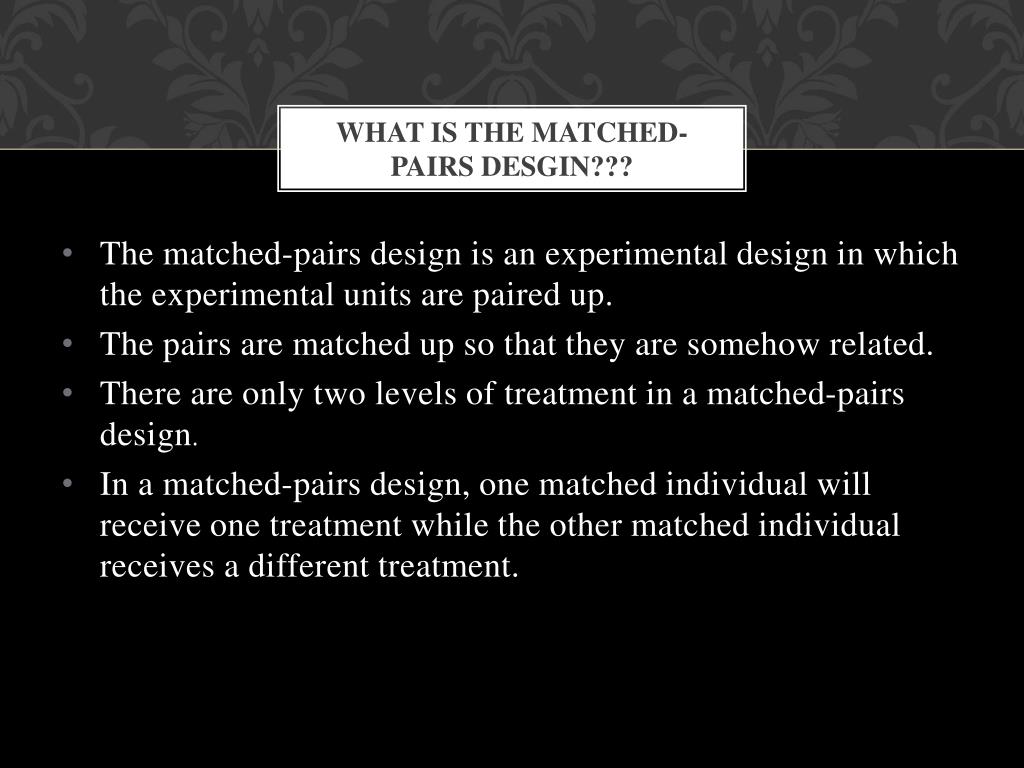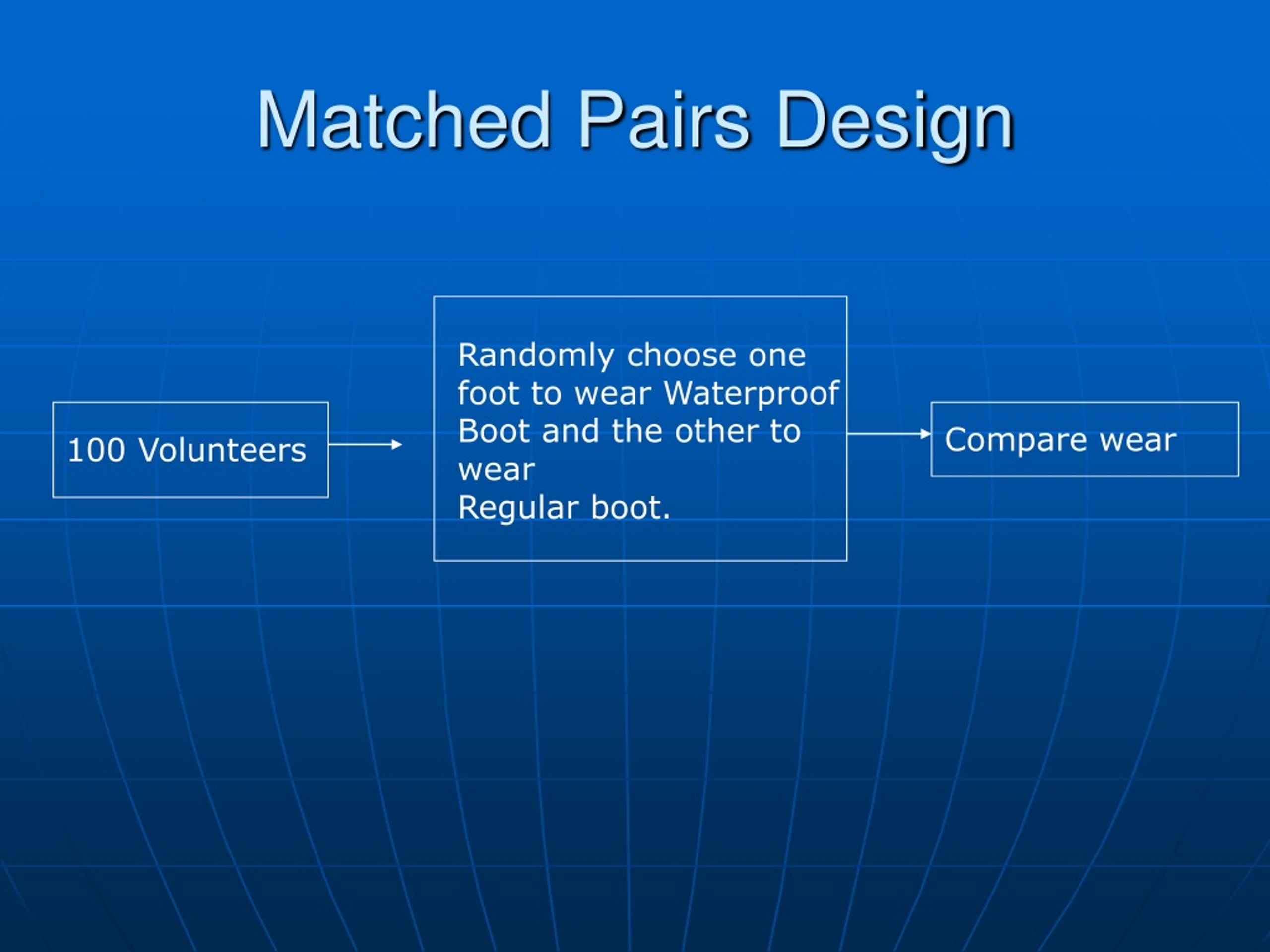10 4 Matched or Paired Samples Introductory Statistics
Table Of Content

Are the sensory measurements, on average, lower after hypnotism? Suppose researchers want to know how a new diet affects weight loss compared to a standard diet. Since this experiment only has two treatment conditions (new diet and standard diet), they can use a matched pairs design.
Key Principles Of Matched Pair Design
In the past model, both age and orientation can altogether affect weight reduction. Finally, for large sample sizes, matching is not necessary since the study groups are already balanced at baseline just by randomn assignment. Pair-matching benefits studies with small samples sizes where it is difficult to obtain balanced groups by complete random allocation.
How to Find Sample Variance on a TI-84 Calculator
One member of each pair is then placed into the experimental group and the other member into the control group. Confidence intervals may be calculated on their own for two samples but often, especially in the case of matched pairs, we first want to formally check to see if a difference exists with a hypothesis test. If we do find a statistically significant difference then we may estimate it with a CI after the fact. At the end of the time time period of 2 months, researchers will measure the total weight gain for each subject. No matter how hard researchers try, there will always be some variation within the subjects in each pair.
Analyzing Data From Matched Pair Experiments
Matched pair design statistics offer a unique lens through which researchers can observe the effectiveness of interventions. This design reduces variability and increases the statistical power of the study. By looking at specific case studies, we can explore how this design enhances the reliability of results in various fields.
The precise pairing process and controlled environment this design offers help scientists and researchers isolate the impact of their variables of interest. A matched pairs design boosts statistical power by reducing variability, ensuring that comparisons between conditions are more precise and require fewer subjects. Experimental design refers to how participants are allocated to different groups in an experiment. Types of design include repeated measures, independent groups, and matched pairs designs.
Extraneous variables (EV)
Conduct a hypothesis test to determine whether the mean difference in distances between the children’s dominant versus weaker hands is significant. Seven eighth graders at Kennedy Middle School measured how far they could push the shot-put with their dominant (writing) hand and their weaker (non-writing) hand. They thought that they could push equal distances with either hand. This design shines in control, but these limitations need careful thought. Creating pairs this way leads to more reliable comparisons.
Research Methods: MCQ Revision Test 1 for AQA A Level Psychology
A random sample of 15 cities is obtained and the following rental information obtained. To assess the difference in reading comprehension between 7 and 9-year-olds, a researcher recruited each group from a local primary school. They were given the same passage of text to read and then asked a series of questions to assess their understanding.

Another problem of matching on several variables is that it increases the difficulty of finding appropriate matches. By improving the comparability of the study participants, matching may also increase the power of the study (the probability of finding an effect when, in fact, there is one). As we will see below in the limitations of pair-matching, if a variable is used as a matching variable, its effect on the outcome can no longer be analyzed in the study. One way to make it slightly easier to find subjects that match is to use ranges for the variables you’re attempting to match on.
Other studies may compare various diet and exercise programs. Politicians compare the proportion of individuals from different income brackets who might vote for them. Students are interested in whether SAT or GRE preparatory courses really help raise their scores. At UA High School there is a summer institute to improve the skills of high school teachers of foreign languages.
The groups are classified either as independent or dependent. Independent samples consist of two samples that have no relationship, that is, sample values selected from one population are not related in any way to sample values selected from the other population. Dependent samples consist of two groups that have some sort of identifiable relationship. Using the differences data, calculate the sample mean and the sample standard deviation. One member of each matched pair must be randomly assigned to the experimental group and the other to the control group. In cases where matching takes a lot of time and work to implement, we can instead invest in increasing the sample size and running a simple randomized controlled experiment.

This method enhances the accuracy of statistical results, leading to more trustworthy conclusions. Embrace this approach to strengthen your research endeavors and glean meaningful insights from your data sets. Case studies in clinical trials show how matched pair design elevates research quality.
A matched pairs design is a type of experimental design wherein study participants are matched based on key variables, or shared characteristics, relevant to the topic of the study. Then, one member of each pair is placed into the control group while the other is placed in the experimental group. Participants are assigned to each group using random criteria, so as to avoid any potential bias. In a hypothesis test for matched or paired samples, subjects are matched in pairs and differences are calculated. The population mean for the differences, μd, is then tested using a Student's-t test for a single population mean with n – 1 degrees of freedom, where n is the number of differences.
Propensity Score Matching: A Guide to Causal Inference - Built In
Propensity Score Matching: A Guide to Causal Inference.
Posted: Fri, 17 Feb 2023 08:00:00 GMT [source]
This piece delves into the intricate process of peeling back the layers of matched pair data. To make sure your matched pair design shines, always review your variables and pairing techniques. Get them right, and you’re on track for trustworthy, valuable results. Understanding the key principles of Matched Pair Design can enhance the accuracy of statistical studies. This design pairs participants closely based on specific criteria.
The objective of both is to balance baseline confounding variables by distributing them evenly between the treatment and the control group. The matched pairs design is best suited to studies that have small sample sizes where it is harder to obtain balanced groups by using random allocation alone. Additionally, this research design can only be used in studies with two treatment conditions.
At a 5% level of significance, from the sample data, there is not sufficient evidence to conclude that the strength development class helped to make the players stronger, on average. Repeated Measures design is an experimental design where the same participants participate in each independent variable condition. This means that each experiment condition includes the same group of participants. In the previous example, both age and gender can have a significant effect on weight loss. A matched pair in AP Statistics refers to two related observations, often the same subject before and after a treatment, used for comparison in paired samples or experiments. Matched pair design, a vital component of experimental research, pairs similar subjects or groups together to minimize variability in the results.
Patients with similar attributes like age and health status create pairs. This direct comparison often reveals which treatment works best. Additionally, matched pairs design can only be used when there are two treatment conditions so that one person from each pair can be assigned the first treatment and the other can be assigned the second treatment. No, since a matched pairs design is an experiment, and experimental designs are essentially not susceptible to confounding. Matched pairs design is an experimental design where pairs of participants are matched in terms of key variables, such as age and IQ.
Komentar
Posting Komentar